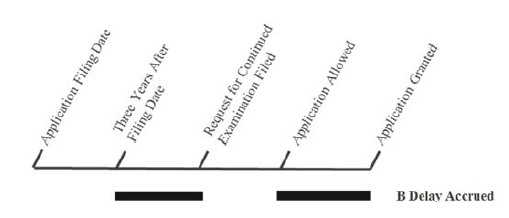On January 15, 2014, the U.S. Court of Appeals for the Federal Circuit decided Novartis v. Lee (No. 2013-1160, -1179), holding that time spent in “continued examination” is excluded from a patent term adjustment even where the continued examination occurs after the application has been pending for more than three years. However, the Federal Circuit also held that the time excluded for continued examination is limited to the time before allowance of the application, and therefore positive patent term adjustment accrues from the date the application is allowed to issuance of the patent, as long as no later examination occurs.
Patent Term Adjustment
Applicants may be entitled to patent term adjustment (PTA) to remedy certain delays caused by the U.S. Patent and Trademark Office (USPTO) during prosecution of an application. 35 U.S.C. § 154 specifies the patent term guarantees which, if not met, can serve as bases for PTA. In particular, § 154(b)(1)(B) provides one day of PTA for every day an application is pending for more than three years (known as “B delay”). According to § 154(b)(1)(B)(i), B delay does not include “any time consumed by continued examination of the application,” such as the filing of a Request for Continued Examination.
The Federal Circuit’s Decision
According to Novartis’ interpretation of the statute, applicants are entitled to PTA for any time spent by the USPTO after three years from the application filing date, even if continued examination has been requested. In contrast, the USPTO argued that the statutory language clearly excludes any time consumed by continued examination, no matter when it was initiated.
The Federal Circuit agreed with the USPTO, stating that PTA “should be calculated by determining the length of time between application and patent issuance, then subtracting any continued examination time and determining the extent to which the result exceeds three years.” The Federal Circuit also found the USPTO’s construction was otherwise supported by the statutory purpose and structure.
However, the Federal Circuit agreed with Novartis on the other statutory interpretation issue. Novartis argued that time consumed by continued examination should be limited to the time before allowance of an application, as long as no later examination actually occurred, while the USPTO argued that any time up until issuance of a patent should be excluded. The Federal Circuit rejected the USPTO’s reasoning, indicating that because a case not involving continued examination would undisputedly be entitled to the time from allowance to issuance, there was no basis for treating a case involving continued examination differently.
The following schematic illustrates the Federal Circuit’s holding:





 />i
/>i
